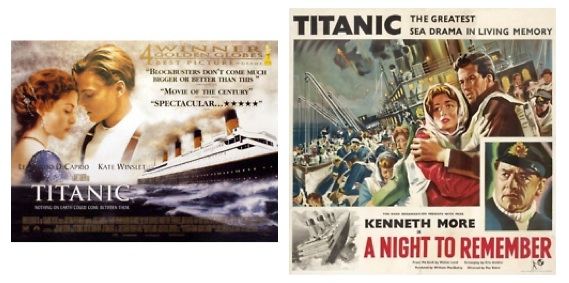Titanic
Written and directed by James Cameron
USA, 1997
A Night to Remember
Written by Eric Ambler
Directed by Roy Ward Baker
UK, 1958
Marking the 100th anniversary of the disaster, the two most famous films about the Titanic sinking have received the restoration and re-release treatment, albeit one of them on a much grander scale. The 1958 British production A Night to Remember, from director Roy Ward Baker, has been given a new digital restoration, receiving blu-ray treatment in North America courtesy of The Criterion Collection and a limited theatrical run in select cities in the United Kingdom. James Cameron’s Titanic, meanwhile, has been converted into 3D for a worldwide re-release. This revival of the world’s previous highest grossing film allows for re-evaluation on the part of its critics, re-familiarisation for its fans, and a chance for those who missed it on the big screen the first time round, like this writer, to see it through the means in which it most thrives, with or without 3D immersion.
Upon revisiting Titanic, the most striking thing is just how well the film has held up and improved over time. Cameron’s much maligned screenplay, for instance, gets a lot more right than it does wrong. The sections with the contemporary framing device are quite bad, some of the supporting characters are poorly realised archetypes, and there’s a fair few instances of problematic exposition. The love story, however, is actually very strong, successfully aping David O. Selznick’s brand of grand, sweeping melodrama to great effect and easily surviving any damage caused by some of Cameron’s occasional dialogue issues. Furthermore, as manipulative as the film is, the depiction of the disaster is nonetheless highly effective on an emotional level: the montage of the doomed set to the strings of the ship’s band, and the lone returning lifeboat’s wafting through the frozen dead, remain absolutely devastating sequences. Avoiding exploitation of the tragedy, the ballad of Jack and Rose acts as just a gateway into a story of history and human disaster; their journey throughout the ship, as well as those of minor characters, allowing for the depiction of each facet of the catastrophe that is suitably horrific and draining.
Age has helped Titanic’s lead performances. Leonardo DiCaprio’s Jack now seems less of a pretty young thing and more a clear sign of his skills as a leading man, while Kate Winslet’s Rose acts as a reminder of just how good she has always been from the early stages of her career. Billy Zane’s Cal, one of the less deftly executed characters, has unfortunately got worse, as has Frances Fisher’s one-note icy matriarch and Danny Nucci’s painful Italian stereotype, but there’s better support from the likes of the soulful ship architect portrayed by Victor Garber. What has also helped the film age well is its reliance on practical effects and details despite the numerous CGI flourishes, the film’s visceral quality in its second half stemming from its placement of actors in staggeringly executed sequences of peril and destruction. Curiously, the impressive 3D conversion best aids the details of the sets prior to the sinking, adding immersive texture to the meticulous recreation of the ship. Rather than feeling like a gimmick, the technique adds a unique quality to the already impressive big screen spectacle, perhaps the last of its kind in a digital age increasingly distancing itself from physical effects on a grand scale.
Similarly reliant on the physical, due to a matter of necessity in 1950s filmmaking, is A Night to Remember, a work arguably more inventive on a technical level in its visualisation of the ill fated voyage. Taking an almost documentarian approach to the story, the film has no singular protagonists, with Kenneth More being the star of the piece only nominally. Touching on various aspects of the situation, including the men on nearby boats sent distress calls, the film’s focus is more concerned with providing an accurate, heavily detailed sense of every aspect of the disaster. As such, there is a distinct lack of sentimentality, most evident in its unnerving lack of score through much of its running time and a matter-of-fact treatment of the passengers’ various personal tragedies. While Titanic, in its admirable bombast, switches from liveliness to horror, Baker’s more sombre film is consistently succinct and reserved, a quality that renders it both gripping, unsettling and devastating in a completely different way, and this is before it even detours into a more frenzied approach in its final stretch.
While some of the effects work is occasionally bothersome, much of the sinking’s visualisation works well, the film thriving on creative composition through askew camera angles and soundstage manipulation; see scenes in which unaware first class passengers go about their business in a dining room, unaware of their increasingly tilted environment that the viewer is made clearly aware of. The production having involved anecdotal information from many survivors, the film is known as the most accurate telling of the Titanic story. This status does not make it automatically superior to Cameron’s film; the two films indeed share an arguable flaw in their acts prior to the iceberg collision not being entirely well realised. Despite both being concerned with the human tragedy of the event, they are very different and equally valid offerings. However, lacking as it does in an awkward framing device, the powerful docudrama leanings of A Night to Remember offer what is perhaps a more consistently effective portrayal.
Josh Slater-Williams




